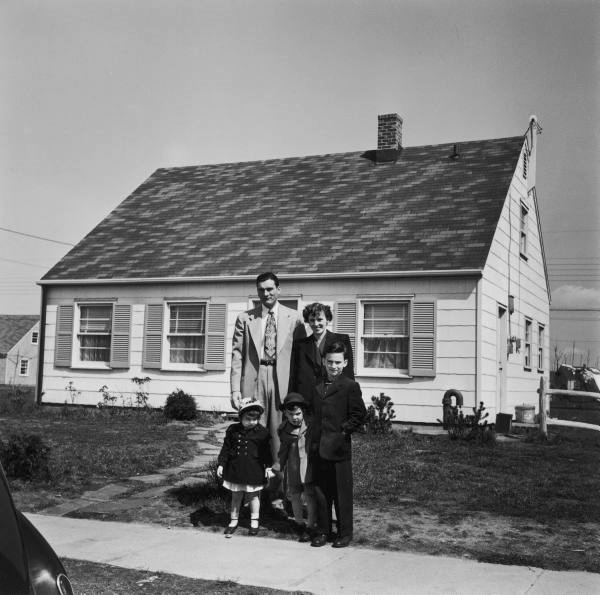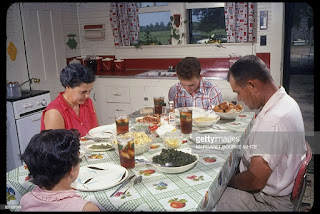 Growing up I lived in several simple wood frame houses. My mother enjoyed flipping houses before there was such a thing. Usually it was to get the family out of debt. The rooms in these houses were small, bedrooms had barely enough space to get around the bed, closets were so small they could be mistaken for phone booths. Most of them had no formal dining room, none had more than three bedrooms. Yet we managed and I don't ever remember my parents suggesting that we would be even the least bit happier if we only had more space.
Growing up I lived in several simple wood frame houses. My mother enjoyed flipping houses before there was such a thing. Usually it was to get the family out of debt. The rooms in these houses were small, bedrooms had barely enough space to get around the bed, closets were so small they could be mistaken for phone booths. Most of them had no formal dining room, none had more than three bedrooms. Yet we managed and I don't ever remember my parents suggesting that we would be even the least bit happier if we only had more space.The same sort of houses were built in Levittown, NY after WWII in the late 1940's and early 1950's, designed to be affordable with the potential of being expanded over time as the family grew and money permitted.
There were variations in the floor plans but they were generally the same box house with a Cape Cod exterior. Homes like these sprang up all across America providing the shelter that facilitated the happy memories of thousands of families. What all these houses, including the ones I grew up in had in common was the kitchen table.
The trend in housing today is a phenomenon I find fascinating. It's a thing referred to as "open concept."
I don't actually think architects in past decades had a concept other than meeting the needs of a family--which would naturally include a mother, a father and their children. If you look at floor plans of homes from previous periods in American history you won't find many that include more than a few rooms not common to each, regardless of the "style" of the house. The basic shelter needs are the same whether you are rich or poor. You may have a few more bedrooms, an enclosed porch, or an additional bathroom, but for the longest time, kitchens in particular remained the same. They were a workspace, not the place to entertain your guests. They were not dramatic or expensive. They were a functional space for daily meals with the family.
 |
| Julia Child's Kitchen |
Take Julia Child's kitchen for example.
Built in 1961 by her husband Paul, it was designed for a person who liked to cook. It was efficient, but a long way from what anyone today would call luxurious. It was about as glamorous as the inside of a man's tool shop. In the middle of the room was a rectangular wood table, scratched and worn from daily use. The entire kitchen was taken apart a few years ago and reconstructed inside the Smithsonian Museum of American History. It is an important object, worthy of the space it has been afforded, because it was the TV set for Julia's cooking shows that did so much to change the way Americans cook and eat. Women in small kitchens all over the country could observe her conducting the most sophisticated culinary tasks in a kitchen that looked very similar to their own. And she did it with a level of humility that put most viewers, including myself, at ease with making mistakes, of trying new things, of experimenting with techniques we thought beyond our reach. Flipping an omelet for instance. Sure you might have to pick a couple of them off the floor, but so did Julia. The thing was to not stop trying. Learn a few basic skills like sauce making, chopping vegetables, selecting the right knife for the job and you too could be a chef without much effort, which is what women needed and wanted to hear.
 |
| Modern "open concept" kitchen floor plan |
None of these skills has as a prerequisite a large or fancy kitchen. If you listen to most women today on TV's most popular "house hunting shows", you would think it was impossible to prepare food without granite counter tops and stainless steel appliances, a center island, a breakfast bar, a warming drawer and a wine fridge. Julia had none of the above and yet it is she who bears the name of cooking icon extraordinaire. Many of the women buying kitchens today profess proudly to not cook at all. They just know, or think they know, what must be in a kitchen, or else it isn't worth owning. They refer to kitchens with a similar appearance to Julia's as "a total gut," meaning if we buy this house, the kitchen has to go.
I sometimes hear these home buyers declare they won't be needing that formal dining room - it's "not their style", so maybe they can use that space for the play room or the pool table. In the kitchen, the space once devoted to the table and chairs is now taken up by the island, the must have island, with perhaps, but maybe not, a "breakfast bar" on one side. This way, or so they say, "The kids can eat while I cook." This only tells me, no one is sitting with the children, while they eat, correcting their manners, cautioning them not to take bites too large for their mouths, not to gobble, not to eat with their fingers, not to wipe their hands on their clothes, to use their napkins, and all those other little habits which only become habits when they are ingrained on the unending parent tapes that get stored in their little brains.
Many things happen around the kitchen table, or at least they used to. It used to be where women shared their troubles or a few laughs over coffee with a neighbor or a friend. Nightly meals were served on kitchen tables. Discussions of current events, of family problems, of hopes and dreams were held over nightly suppers at the kitchen table. Where does that happen now, when all you have are three bar stools and a counter and you sit in a row like birds on a wire instead of across from each other where you can look one another in the eye and get a true sense of how someone feels about what they are saying?
Entertaining today is often reduced to standing around the island eating finger food from throw away tableware while the children swarm around their parents feet.
There is an expression that as you pray, so will you believe, as you believe, so will you live. Could this be as true in reverse? So that as we live, so will we believe, and as we believe, so will we pray, or not pray?
 |
| Bless us, O Lord, and these thy gifts. |
Makes me long for tradition all the more.

No comments:
Post a Comment